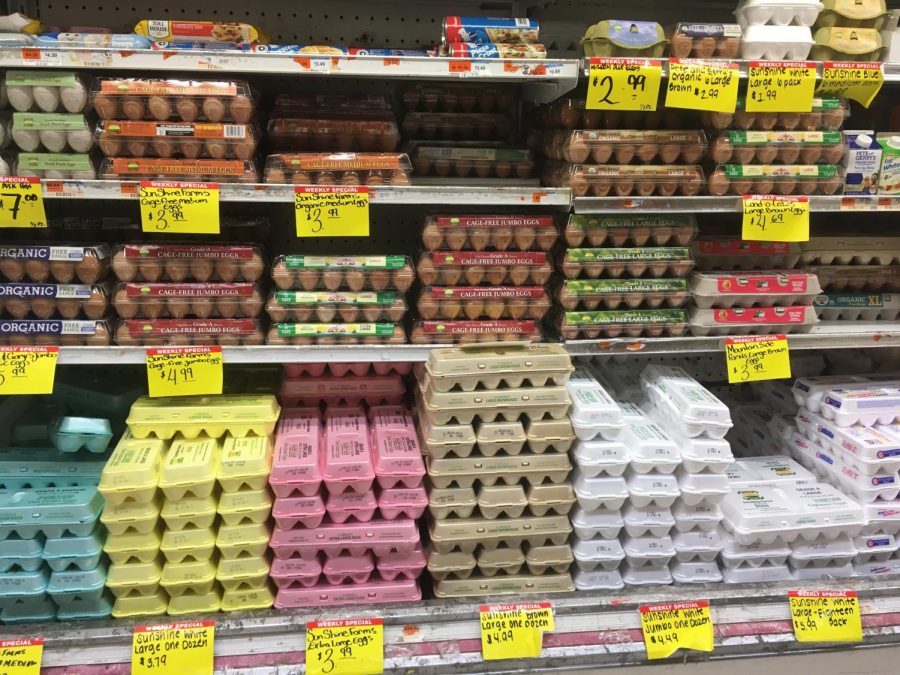Cracking the Code: What the Labels on Your Eggs Really Mean
The broad range of options in the egg aisle can be overwhelming, especially when you don’t know what their labels mean.
April 28, 2020
Eggs: one of the most versatile, nutrient-dense refrigerator staples. Relatively cheap, quick and easy to cook, they have a permanent spot on many students’ grocery lists. They’re delicious scrambled. Fried. Hard-boiled. Soft-boiled. Poached. The list goes on — but it seems like for every way to eat an egg, there’s a different label on the cartons at the grocery store.
When trying to choose among free-range, organic or cage-free or to just grab the cheapest option and head to checkout, deciding which eggs to buy can be a real headache. What does each title on egg cartons really mean?
It’s important to keep in mind the official seals on labels. The U.S. Department of Agriculture (USDA) requires certain conditions to be met in order for specific phrases to be used on packaging. However, many independent organizations advocating for animal welfare offer their own additional certifications, often with more stringent requirements.
Cage-Free
The USDA’s conditions for “cage-free” eggs are that they must be “produced by hens housed in a building, room, or enclosed area that allows for unlimited access to food, water, and provides for the freedom to roam within the area during the laying cycle.” Egg-laying hens are typically raised in battery cages, but hens laying cage-free eggs are not kept in individual enclosures. In theory, they are given barn space in which they may walk around, but many humane organizations point out that factory farms pack chickens in too tightly for them to actually do so, as there are no per-bird space requirements.
Free-Range
The USDA defines “free-range” eggs as those “produced by hens housed in a building, room, or area that allows for unlimited access to food, water, and continuous access to the outdoors during their laying cycle.” This is essentially cage-free, but hens are able to go outside. However, there is no minimum space requirement, and animal advocacy groups assert that outdoor access often just means a “pop hole,” not allowing hens full-bodied outdoor space. Humane Farm Animal Care (HFAC) has additional requirements in order to achieve their Certified Humane free-range label. In addition to the USDA’s rules, they necessitate 2 square feet per bird, and during the outdoor season, hens must be fully outdoors for at least six hours each day.
Organic
Organic eggs are produced by free-range hens who are given only organic feed (feed without chemical additives like pesticides). Additionally, hens producing organic eggs can only be given antibiotics in the case of sickness, whereas conventional hens are given them regularly. No hormones may be used in these chickens. Look for the USDA Certified Organic label to make sure these eggs meet governmental standards.
Pasture-Raised
The USDA has not defined what “pasture-raised” means; therefore, this branding is not regulated by the government. However, independent organizations offer standards for pasture-raised eggs. In order to achieve HFAC’s pasture-raised certification, egg-laying hens must be granted the same conditions as free-range, but with a larger space requirement of 2.5 acres per 1,000 birds, or 108 square feet per bird.
All-Natural, Happy Hens, Farm Fresh, Etc.
This terminology is not regulated by the federal government. Phrases such as “all natural” and “farm fresh” can be used on any carton of eggs, and manufacturers employ them solely for marketing purposes. The USDA notes that terminology such as “happy hens” is “misleading and subjective.”
Grade AA, Grade A and Grade B
The U.S. Poultry and Egg Association notes that the grade given to a carton of eggs is based solely upon their appearance. Grade AA eggs have “thick, firm whites and high, round yolks,” whereas Grade A eggs are the same but have only “‘reasonably’ firm” whites. Grade B eggs have the lowest visual quality, with “thin whites and wider yolks.” Most eggs sold in grocery stores are Grade A.
Where do Fordham’s eggs come from?
As part of sustainability efforts on the Lincoln Center campus, Fordham Campus Dining states that “Humanely Raised Cage Free Shell Eggs are used across campus.” They also note that across all Fordham University campuses, they “purchase local, seasonal and responsibly raised, grown and sourced products whenever possible.” Fordham Dining did not respond to a request for comment.
When it comes to egg cartons, trying to discern between a marketing ploy and actual fact can be a bit of a puzzle. Although it can be confusing, taking time to understand the terminology behind the labels can really pay off. From price to sustainability, plenty of information on your eggs is available right in front of you, as long as you know how to look.












